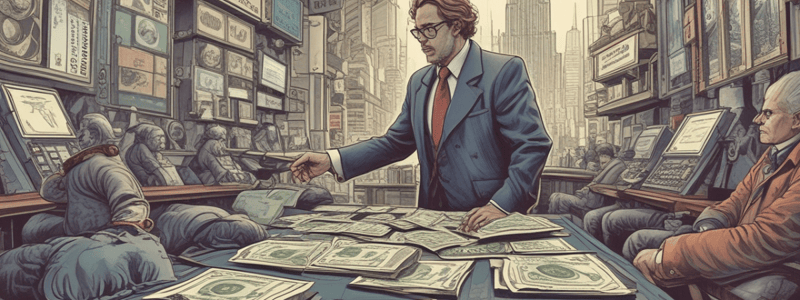Podcast
Questions and Answers
What type of bonds have an embedded option?
What type of bonds have an embedded option?
- Callable bonds
- Convertible bonds
- Mortgages
- All of the above (correct)
An option is at-the-money if immediate exercise would lead to a positive cash flow.
An option is at-the-money if immediate exercise would lead to a positive cash flow.
False (B)
What is the ratio often used to measure the degree of moneyness in empirical research?
What is the ratio often used to measure the degree of moneyness in empirical research?
S t / K
The option premium is quoted per unit of the underlying, and to obtain the total purchase cost, we need to multiply the quoted option premium with the _______________________ and add the transaction costs.
The option premium is quoted per unit of the underlying, and to obtain the total purchase cost, we need to multiply the quoted option premium with the _______________________ and add the transaction costs.
What is the payoff from a contract?
What is the payoff from a contract?
An option is in-the-money if immediate exercise would lead to a negative cash flow.
An option is in-the-money if immediate exercise would lead to a negative cash flow.
Match the following options with their characteristics:
Match the following options with their characteristics:
What are the two components that the premium of an option is often decomposed into?
What are the two components that the premium of an option is often decomposed into?
What is the right granted to the owner of a plain vanilla option?
What is the right granted to the owner of a plain vanilla option?
An American style option can be exercised only on the maturity date.
An American style option can be exercised only on the maturity date.
What is the term used to describe the act of using the right by the option buyer?
What is the term used to describe the act of using the right by the option buyer?
The owner of a plain vanilla option has the right to buy or sell a fixed amount of an underlying at an agreed price, known as the _______________
The owner of a plain vanilla option has the right to buy or sell a fixed amount of an underlying at an agreed price, known as the _______________
Match the following terms with their definitions:
Match the following terms with their definitions:
What can an option owner do on any trading day?
What can an option owner do on any trading day?
A plain vanilla option is a security that gives the owner the obligation to buy or sell the underlying.
A plain vanilla option is a security that gives the owner the obligation to buy or sell the underlying.
On the maturity day, the option can also ______________________.
On the maturity day, the option can also ______________________.
How is the profit diagram of an option often calculated?
How is the profit diagram of an option often calculated?
The time value of money is always considered when calculating the profit diagram of an option.
The time value of money is always considered when calculating the profit diagram of an option.
What is the condition for an option holder to break even?
What is the condition for an option holder to break even?
The profit of a long call option is calculated as Profit = ________________ - premium.
The profit of a long call option is calculated as Profit = ________________ - premium.
Match the following options with their characteristics:
Match the following options with their characteristics:
The profit diagram of a long call option is always positive.
The profit diagram of a long call option is always positive.
What is the notation for the strike price of an option contract?
What is the notation for the strike price of an option contract?
The payoff of a long call option is always positive.
The payoff of a long call option is always positive.
What is the formula for the payoff of a long call option?
What is the formula for the payoff of a long call option?
The payoff of a long put option is equal to max(__ - S, 0) at date T.
The payoff of a long put option is equal to max(__ - S, 0) at date T.
What is the relationship between the payoff of a short call option and a long call option?
What is the relationship between the payoff of a short call option and a long call option?
The payoff of a long put option is always increasing with the spot price.
The payoff of a long put option is always increasing with the spot price.
What is the notation for the value of the call at date T?
What is the notation for the value of the call at date T?
The payoff of a short put option is equal to -max(__ - S, 0) at date T.
The payoff of a short put option is equal to -max(__ - S, 0) at date T.
Match the following options with their payoff diagrams:
Match the following options with their payoff diagrams:
The payoff of a long call option and a short put option are the same.
The payoff of a long call option and a short put option are the same.
Flashcards are hidden until you start studying
Study Notes
Options
- A plain vanilla option is a security that gives the owner the right to buy (call option) or sell (put option) a fixed amount of an underlying asset at an agreed price (strike price, exercise price) at a maturity date (expiration date) (European style) or up to the maturity date (American style).
Definition
- The act of using the right by the option buyer is referred to as exercising the option.
- On any trading day, the owner of the option can retain the option, sell the option at its concurrent market price, or exercise the option if the contract allows it.
- On the maturity day, the option can also expire.
Terminology
- Long position: option buyer (who holds the right to exercise the option)
- Short position: option seller or option writer (who holds the contingent obligation)
- Plain vanilla options: standard European and American calls and puts
- Exotic options: deviate in their specification in one way or another from vanilla options, e.g. barrier options, Asian options, lookback options, compound options
Terminology (continued)
- Embedded options: callable bonds, convertible bonds, mortgages
- Real options
Moneyness
- In-the-money: if immediate exercise would lead to a positive cash flow
- Call: if S > K
- Put: if S < K
- Out-of-the-money: if immediate exercise would lead to a negative cash flow
- At-the-money: if immediate exercise would lead to a zero cash flow
- The ratio S/K is often used to measure the degree of moneyness
The Quoted Premium
- The option premium is quoted per unit of the underlying
- To obtain the total purchase cost, the quoted premium is multiplied with the contract size, and transaction costs are added
- The premium is often decomposed into an intrinsic value (i.e. S - K) and a time value (i.e. premium - intrinsic value)
Payoff and Profit
- Payoff: the net cash flow generated by the contract at maturity date
- Payoff profiles:
- Long call: max(S - K, 0)
- Short call: -max(S - K, 0)
- Long put: max(K - S, 0)
- Short put: -max(K - S, 0)
- Profit diagrams:
- Long: payoff - premium
- Short: payoff + premium
Breaking Even
- The option holder will break even (i.e. realize a zero profit) if:
- The long regains the paid premium
- The short loses the received premium
Studying That Suits You
Use AI to generate personalized quizzes and flashcards to suit your learning preferences.




